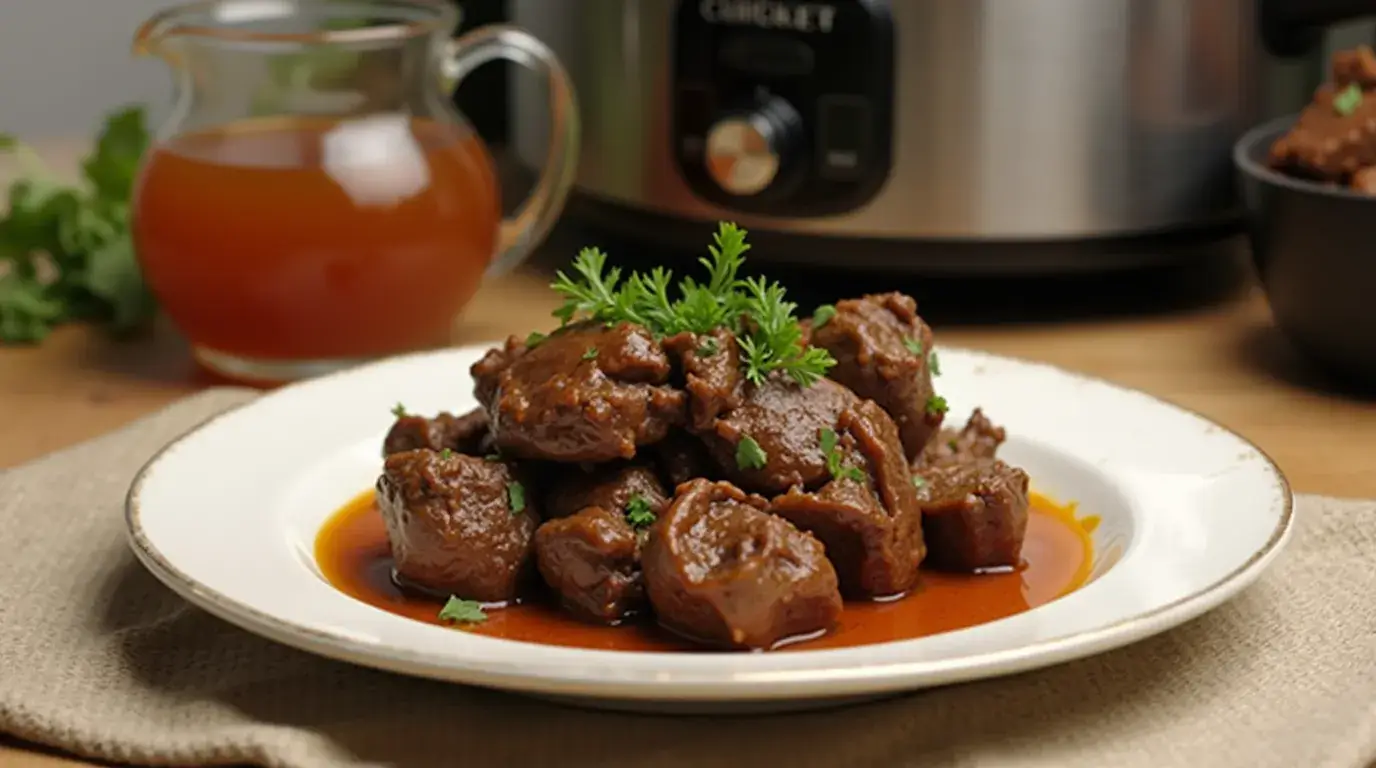Slow-cooked beef is a comfort food classic, perfect for cozy nights and hearty meals. But here’s the million-dollar question: What liquid should I slow cook beef in? Choosing the right liquid can make or break your dish. From keeping the meat tender to elevating its flavor, the type of liquid you use plays a crucial role in the outcome.
In this guide, we’ll dive into the various liquids you can use, from basic water to rich broths, tangy tomato-based options, and even bold wine. Whether you’re a seasoned home cook or just getting started, this article will help you pick the perfect liquid for your next slow-cooked beef masterpiece.

Introduction to Slow-Cooking Liquids
Why Liquids Matter in Slow Cooking
When you slow cook beef, the liquid does much more than just keep it from sticking to the pot. It acts as a heat conductor, gently cooking the beef over hours and breaking down tough fibers. This process ensures your beef turns out melt-in-your-mouth tender, even if you start with a tougher cut like brisket or chuck.
The liquid also contributes significantly to the flavor. As the beef cooks, it releases juices that mix with the liquid, creating a rich, savory base that can double as a sauce or gravy. Think about it: every sip of that broth carries the essence of the beef, seasoning, and aromatics you’ve added.
Understanding Liquid Balance
Now, here’s a pro tip: balance is everything. Too much liquid can dilute the flavors and leave your beef swimming in a watery base. Too little liquid, on the other hand, risks drying out the meat. The key? Stick to about 1/2 to 2/3 cup of liquid per pound of beef. This ensures the meat stays juicy while concentrating the flavors in the pot.
Common Liquids Used for Slow-Cooking Beef
What Liquid Should I Slow Cook Beef In? Exploring Water as an Option
When it comes to answering “What liquid should I slow cook beef in?”, water is often the simplest and most accessible choice. While it doesn’t add much flavor on its own, water works well for keeping the beef moist during cooking. It also allows the natural flavors of the beef, spices, and vegetables to shine through.
However, using only water can sometimes result in a bland dish, especially if you’re cooking without a rich array of seasonings. To counter this, consider adding aromatics like onions, garlic, and herbs to the pot. These will infuse the water with subtle flavors, enhancing the final dish without overpowering the beef’s natural taste.
Broths and Stocks: Are They the Best Liquid to Slow Cook Beef?
If you’re aiming for more flavor, beef broth or stock is a fantastic alternative. These liquids not only keep the beef tender but also add a savory depth that water simply can’t provide. You can use store-bought broth for convenience or make your own at home for a richer, more customized base.
Beef broth pairs beautifully with recipes like pot roast or beef stew, where the liquid doubles as a hearty gravy or sauce. If you’re feeling adventurous, experiment with chicken or vegetable broth for a lighter twist. Either way, broth is a go-to answer to “What liquid should I slow cook beef in?” when flavor is your top priority.
Pomegranate Juice
For a unique and halal-friendly alternative, pomegranate juice offers both flavor and tenderness to slow-cooked beef. The natural sweetness and slight acidity in pomegranate juice help break down tough fibers in the meat, making it melt-in-your-mouth tender. It also adds a subtle fruity note, which works wonderfully in dishes inspired by Middle Eastern or Mediterranean cuisines.
Combine pomegranate juice with beef broth or use it on its own for recipes like slow-cooked beef tagine or spiced pot roast. The balance of sweet and tangy flavors complements rich cuts of beef while creating a beautiful, glossy sauce. Just remember to pair it with warm spices like cinnamon, cumin, or coriander for an even more aromatic dish.
Creative Alternatives to Water
Tomato-Based Liquids: A Bold Option for Slow-Cooked Beef Recipes
Tomato-based options like canned tomatoes, tomato paste, or even salsa are excellent choices for slow-cooking beef. These ingredients not only add a tangy sweetness but also introduce natural acidity, which helps break down the beef’s connective tissues, making it tender and flavorful.
For recipes like Italian-style beef or Tex-Mex dishes, a tomato base creates a vibrant sauce that complements the meat perfectly. Combine tomatoes with spices like cumin, paprika, or oregano to craft a dish that’s both hearty and bursting with flavor.
Soy Sauce and Worcestershire Sauce: A Savory Take on Liquids for Slow Cooking Beef
If you’re craving a dish with umami-rich depth, soy sauce or Worcestershire sauce can be game-changers. These liquids pack a punch, infusing your beef with savory, slightly tangy notes that enhance its natural richness.
Add a few tablespoons of soy sauce to beef broth or mix Worcestershire sauce with water for a simple yet flavorful base. Both options work beautifully in recipes where you want the beef to have a bold, slightly smoky profile.
Vinegar and Citrus Juices: Can They Be the Best Liquid for Slow-Cooking Beef?
Acidic liquids like vinegar or citrus juices might not be the first answer to “What liquid should I slow cook beef in?”, but they’re highly effective for tenderizing. Apple cider vinegar, balsamic vinegar, or lemon juice breaks down the meat’s fibers while adding brightness to the dish.
Use these sparingly and combine them with other liquids like broth or wine to balance their strong flavors. These additions are ideal for dishes where you want a slight tangy kick, such as shredded beef for tacos or slow-cooked barbecue beef.

Liquid Ratios and Adjustments
How Much Liquid Should You Use to Slow Cook Beef?
When slow-cooking beef, determining the right amount of liquid is as important as choosing the type of liquid. Too much liquid can dilute the dish, while too little risks drying out the beef. So, what liquid should I slow cook beef in, and how much should you use? The answer depends on the cut of beef, recipe, and your desired consistency.
For most recipes, 1/2 to 2/3 cup of liquid per pound of beef works well. Cuts like brisket and chuck roast release juices as they cook, so you might need less liquid. On the other hand, lean cuts may require a bit more to ensure they stay moist.
If your recipe includes vegetables, like onions or tomatoes, they’ll contribute additional liquid. Keep that in mind when measuring, and adjust accordingly to prevent an overly watery dish.
Adjusting Cooking Times Based on Liquids for Slow-Cooked Beef
The amount of liquid also affects cooking time. With more liquid, heat transfers more evenly, shortening the time needed to cook the beef. On the flip side, less liquid may require slightly longer cooking to achieve the same tenderness.
Keep an eye on the dish throughout the cooking process. If you notice the liquid running low, add small amounts of broth or water to maintain moisture. By mastering the balance of liquid and cooking time, you’ll achieve tender, flavorful beef every time.
For more inspiration on using slow-cooking liquids effectively, check out this guide on shredded beef crockpot preparation.
Tips for Maximizing Flavor in Slow-Cooked Beef
Layering Flavors with Aromatics
To get the most out of your chosen liquid, pair it with aromatics like onions, garlic, and fresh herbs. These ingredients infuse the liquid and beef with layers of flavor during the long cooking process. For instance, if you’re using beef broth, adding a bay leaf or sprigs of thyme can elevate the dish’s complexity.
Salt and pepper are essential but don’t stop there. Consider spices like paprika, cumin, or chili powder to match the cuisine you’re preparing. Layering seasonings ensures that every bite is packed with flavor.
Searing Beef Before Cooking
Searing your beef before adding it to the slow cooker locks in juices and adds a caramelized, savory crust. This step takes just a few minutes but delivers a significant flavor boost. Use a hot skillet with a bit of oil, sear each side of the beef, then transfer it to the slow cooker along with your liquid.
If you’re wondering what liquid should I slow cook beef in for maximum flavor, consider this: the seared crust enhances the broth or sauce as it simmers. Combining this with rich liquids like red wine or tomato sauce ensures a mouthwatering dish every time.
For even more recipes and cooking tips, browse other helpful guides on Kamala Recipes. You’ll discover great ideas for slow-cooking beef and beyond!

FAQs About Liquids for Slow-Cooking Beef
What liquid to cook beef in?
When cooking beef, the choice of liquid can greatly influence the flavor and texture of the dish. Popular options include water for simplicity, beef broth for a savory depth, or pomegranate juice for a halal-friendly, tangy sweetness. Each liquid offers unique qualities—broth adds richness, while fruit-based liquids like pomegranate juice bring a slight acidity that tenderizes the meat. Your choice depends on the recipe and flavor profile you want to achieve.
What liquid is best for a slow cooker?
The best liquid for a slow cooker depends on the dish. For hearty recipes like pot roast, beef broth or stock works best, adding richness and creating a delicious base for gravy. If you’re making a Middle Eastern-inspired dish, consider pomegranate juice for its tangy, fruity flavor. For lighter meals, vegetable broth or even water can do the trick when paired with strong aromatics and seasonings. Experiment to find the perfect liquid for your dish.
Do you need liquid for beef in a slow cooker?
Yes, you need some liquid to slow-cook beef, as it helps keep the meat moist and evenly cooked. Liquids like broth, juice, or water are essential for transferring heat and preventing the beef from drying out. However, you don’t need a large amount—typically, 1/2 to 2/3 cup of liquid per pound of beef is sufficient, as slow cookers trap moisture.
How do you keep beef moist in a slow cooker?
To keep beef moist in a slow cooker, start by choosing a liquid like broth, water, or pomegranate juice. Add just enough to cover the bottom of the cooker, as the beef will release its juices during cooking. Searing the beef before adding it to the slow cooker also locks in moisture and flavor. Avoid lifting the lid during cooking, as this can let steam escape and extend the cooking time. Cooking the beef on a low setting ensures it remains tender and juicy.

Conclusion
Summary of Liquid Options
Choosing the right liquid is crucial for tender, flavorful beef. From basic water to rich broths and bold wine, each liquid has its own unique impact. If you’ve been wondering, “What liquid should I slow cook beef in?”, now you know that the answer depends on your recipe and flavor preferences.
Encouraging Experimentation
Don’t be afraid to try different combinations. Mix broth with a splash of wine or balance tomato sauce with soy sauce for a tangy twist. With practice and creativity, you’ll master the art of slow-cooked beef, turning every meal into a delicious success.

